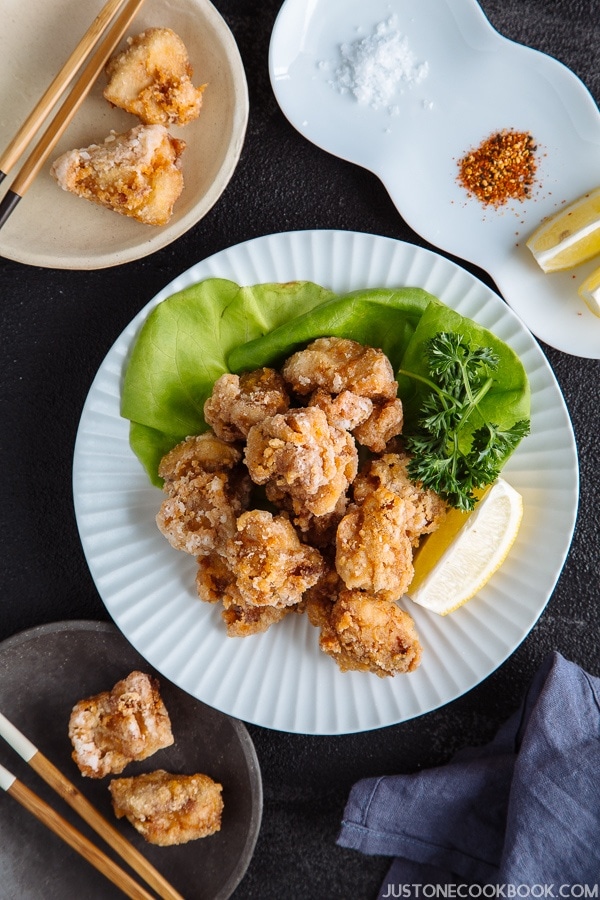
Karaage (唐揚げ) is a Japanese version of fried chicken, famous for its juicy meat and crispy shell. It’s one of the popular appetizers at Japanese restaurants and izakaya (tapas) style restaurants, but in Japan, it’s also enjoyed as a main meal at home or teishoku (Japanese set-meal) style restaurants.
Some dishes are harder to convert into gluten-free options, but not for today’s recipe. This Gluten Free Karaage (グルテンフリー唐揚げ) is so easy to make that I honestly feel this karaage is much better in texture than my regular karaage that uses soy sauce and flour.
So, if you were going to make karaage for everyone, including those who are gluten intolerant, don’t make two versions; just make this recipe!
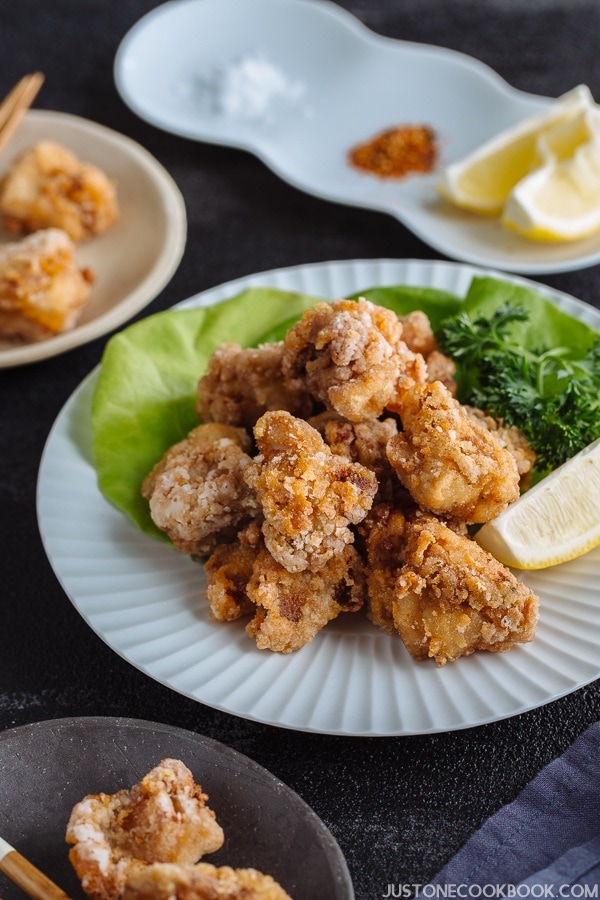
3 Tips for the Best Gluten-Free Karaage
1. Use Skin-On Chicken Thigh
If you are looking for the authentic and ultimate experience to enjoy chicken karaage, you have to get skin-on chicken thighs. It is a necessity, not an option. Again, not skinless, not chicken breasts.
Although it’s higher in calories, chicken skin contains a good amount of heart-healthy unsaturated fat. Cooking the chicken with the skin on helps keep the meat moist and flavorful.
An American butcher sells skin-on chicken thighs with bones, so you can ask the butcher to remove the bones for you or do so easily at home.
2. Rice flour to Potato Starch ratio
For regular karaage, the chicken is marinated, and then coated with wheat flour, potato starch, or a combination of both. However, for gluten free version, we are using rice flour instead of wheat flour, just like Gluten Free Tempura recipe. I personally like the combination of rice flour and potato starch (ideally potato starch, not corn starch), and after I’ve played with the ratio, I like somewhere between 4 to 1 (4 parts potato starch, 1 part rice flour). You can try different ratios and see which ratio gives you the crispiest crust for chicken karaage.
3. Double Fry
Double frying is a must, and here’s why. After the chicken pieces have gone through the first fry and cooled, moisture inside the meat moves to the surface, and that’s when the crispy shells get soggy. Therefore, you deep fry them for the second time to make them extra crunchy again.
Also, while resting for the second fry, the chicken will continue to cook with the remaining heat. The chicken will get drier if you continue cooking with high heat, so double frying does the job for both inside and outside the chicken.
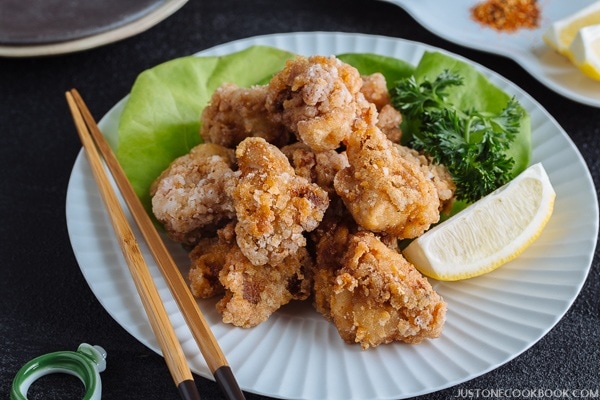
How to Enjoy Gluten-Free Karaage
Now that you have learned how to perfect gluten-free karaage, you want to know how to enjoy it in authentic Japanese style!
Here are some variations on how you can enjoy every piece of chicken karaage.
1. Classic style – lemon juice
Karaage is always served with lemon wedges so you can squeeze some lemon juice over the karaage. Lemon juice helps with digestion and gives a sour note that diminishes the fat sensation of fried food.
2. Everyone’s favorite – Japanese mayonnaise
Next to lemon wedges, there is always a generous squirt of Japanese mayo (homemade recipe here). The Japanese love (Japanese) mayonnaise. Deep-fried foods like karaage, calamari, and chicken katsu always go well with Japanese mayo.
3. Make it light (so we can eat more!) – ponzu sauce
The Japanese like fried foods, but to make it lighter, ponzu sauce (homemade recipe here) is often used as a dipping sauce for deep-fried foods. Often, grated daikon and green onions are added to the ponzu sauce.
A winning crowd pleaser, you want to serve this ultra-crunchy gluten-free karaage at your next party. And don’t forget to bring out the beer (or sake)!
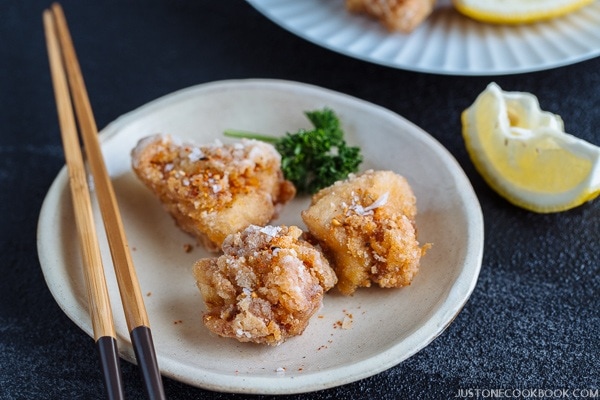
What Makes It Gluten Free?
Usually, Karaage is marinated with soy sauce (not GF) and then dusted with flour (not GF) or potato starch (GF), or a combination of the two. Everyone has different methods and recipes for making a rather simple fried chicken recipe.
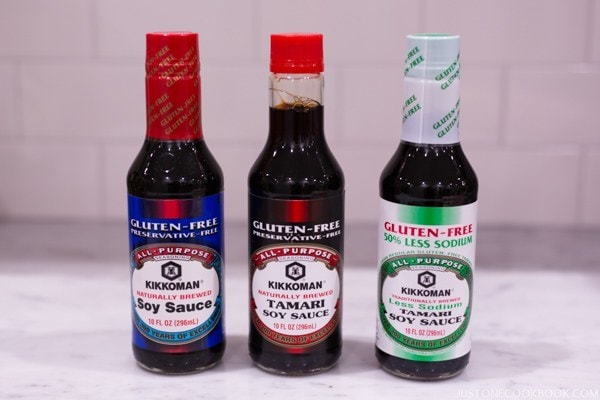
For the gluten-free version, I used Gluten-Free Soy Sauce and coated it with a combination of rice flour (GF) and potato starch (GF).
Potato starch gives crips texture, while rice flour creates an exceptional crunchy outer layer for the chicken. You are not missing anything from the regular version of karaage. In fact, I really think it yields a much superior texture.
Gluten Free Karaage
Ingredients
- 1.1 lb boneless, skin-on chicken thighs
- Diamond Crystal kosher salt
- freshly ground black pepper
- 4 Tbsp potato starch or cornstarch
- 1 Tbsp rice flour
- 2½ cups neutral oil
For the Marinade
- 1 knob ginger (1 inch, 2.5 cm)
- 1 clove garlic
- 2 Tbsp sake
- 2 Tbsp gluten-free soy sauce
For Serving
- lemon wedges
- parsley (optional)
- lettuce (optional; I used butter lettuce)
- shichimi togarashi (Japanese seven spice) (optional; for a spicy kick)
- Japanese Kewpie mayonnaise (optional; for dipping)
Instructions
- Before You Start…Please note that this recipe requires 30 minutes of marinating time.Gather all the ingredients.
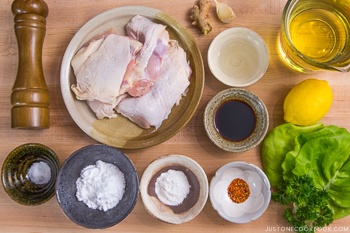
To Marinate the Chicken
- Peel and grate 1 knob ginger and crush (or mince) 1 clove garlic. In a large bowl, whisk all the ingredients for the marinade: the grated ginger, the crushed garlic, 2 Tbsp sake, and 2 Tbsp gluten-free soy sauce.

- Cut the 1.1 lb boneless, skin-on chicken thighs into 5 to 6 pieces per thigh, about 1½ inches (3.8 cm) each.

- Lightly season the chicken with Diamond Crystal kosher salt and freshly ground black pepper.

- Add the chicken to the marinade. Coat and rub the chicken with the marinade using your hands or tongs. Set aside for 30 to 60 minutes.

To Dredge the Chicken
- In a medium bowl, combine 4 Tbsp potato starch or cornstarch and 1 Tbsp rice flour and whisk well.
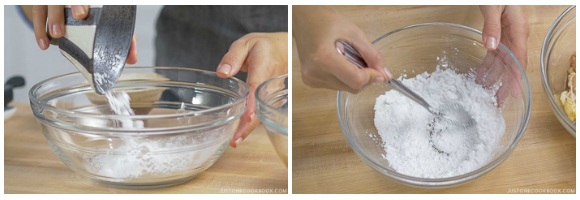
- In a pot, heat 2½ cups neutral oil to 340ºF (170ºC). I use a smaller 1½ QT pot, so that the oil is deep enough and I don‘t have to use much oil. Use a thermometer or wooden chopsticks to see if the oil is ready (for more details, see my post on How to Deep-Fry Foods).

- When the oil is hot, drain the chicken well from the marinade and coat each piece with the potato starch mixture.

To Deep-Fry for the First Round
- Deep-fry for 90 seconds, or until the chicken is light golden color. Work with a few pieces at a time, so the oil temperature won’t drop quickly. I worked with 3 to 4 pieces at a time.
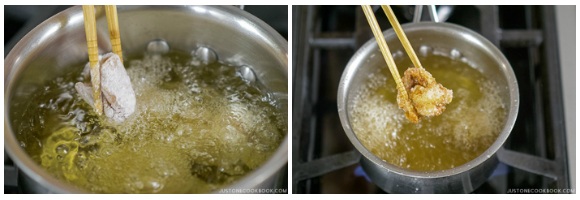
- Transfer the chicken to a wire rack to drain the excess oil. Let the chicken cook with the remaining heat while you work on the rest of the chicken.
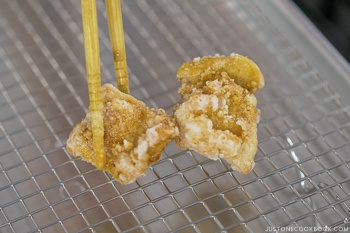
- Once the chicken is all deep-fried for the first round, use a fine-mesh sieve to pick up crumbs to keep the oil clean. If you don‘t do this step, the crumbs will get darker, which will make the oil darker.

To Deep-Fry for the Second Round
- Increase the heat and bring the oil to 350ºF (180ºC). Deep-fry the chicken for the second time for 45 seconds or until crispy and golden brown. Transfer the chicken to a wire rack to drain excess oil.

To Serve
- Serve the chicken immediately with lemon wedges, parsley, lettuce, shichimi togarashi (Japanese seven spice), and Japanese Kewpie mayonnaise. If you‘d like, squeeze with lemon before you eat and sprinkle shichimi togarashi for spice.

Nutrition
Did you make this recipe?
Tag @justonecookbook on Instagram so we can see your delicious creation!
Full Disclosure: This post was sponsored by Kikkoman USA. Thoughts and opinions stated are my own.



